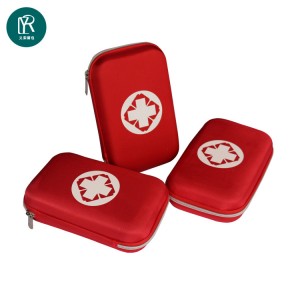Quality Control of EVA First Aid Kits: Full Process Analysis from Design to Delivery
Introduction
In emergency situations, first aid kits are important tools for saving lives. With the advancement of technology and the diversification of user needs, EVA (ethylene-vinyl acetate copolymer) first aid kits have gradually become popular products on the market due to their lightness, durability, and waterproofness. However, the quality of the product directly determines its reliability at critical moments. This article will explore the quality control process of EVA first aid kits in depth, from raw material selection to production, testing, packaging and after-sales, and comprehensively analyze how to ensure that each first aid kit can perform at its best in an emergency.
I. Core advantages and quality requirements of EVA first aid kits
1.1 EVA material characteristics
EVA is a high molecular polymer with the following key characteristics:
Lightness: EVA has low density, light weight, and is easy to carry.
Impact resistance: EVA has good impact resistance and can effectively protect internal items.
Waterproofness: EVA material itself has waterproof properties and is suitable for use in humid environments.
Chemical resistance: EVA has good tolerance to a variety of chemicals, which extends the service life of the product.
1.2 Quality requirements for first aid kits
The quality requirements for first aid kits are much higher than those for ordinary bags, mainly including:
Structural stability: When the first aid kit is impacted by external forces, the internal items should not be damaged.
Sealing: The first aid kit must be completely waterproof to prevent the internal items from getting wet.
Durability: The first aid kit must maintain its performance in extreme environments, such as high temperature, low temperature, humidity, etc.
Ease of use: The design of the first aid kit should facilitate quick access to items, as well as easy cleaning and maintenance.
II. Raw material quality control
2.1 Raw material selection
The main raw materials of EVA first aid kits include:
EVA sheet: For the main structure of the first aid kit, high-density and high-elasticity EVA materials must be selected.
Auxiliary materials: Such as zippers, buckles, webbing, etc., durable and anti-aging products must be selected.
Glue and sealant: For bonding and sealing, non-toxic and weather-resistant materials must be selected.
2.2 Raw material testing
Before purchasing raw materials, strict quality testing is required:
EVA sheet testing: Density test, tensile strength test, impact resistance test, etc. are passed to ensure that the materials meet the standards.
Auxiliary material testing: Durability test of zippers, buckles, etc. to ensure that they can still work normally after multiple uses.
Glue testing: Adhesion test, water resistance test, etc. are passed to ensure that the glue will not fail in various environments.
III. Quality control in the design and development stage
3.1 Product design
The design of the first aid kit must fully consider user needs and usage scenarios:
Ergonomic design: The shape and size of the first aid kit must be ergonomic, easy to carry and operate.
Functional partitioning: The internal design must be reasonably partitioned to facilitate quick access to medicines, tools and other items.
Emergency function: Such as reflective strips, survival whistle, etc., to enhance the emergency response capability of the first aid kit.
3.2 Design verification
After the design is completed, the following verification is required:
Simulation test: Verify the practicality and reliability of the first aid kit by simulating various emergency scenarios.
User testing: Invite professional first aid personnel and ordinary users to conduct tests, collect feedback and optimize the design.
IV. Quality control during production
4.1 Production process
The production process of EVA first aid kits includes:
Cutting and forming: Use high-precision cutting equipment to ensure that the size and shape of the EVA sheet meet the design requirements.
Gluing and assembly: Use hot melt glue or professional glue to bond the components to ensure a firm structure.
Sealing: Seal the seams of the first aid kit to ensure complete waterproofing.
4.2 Quality inspection during production
During the production process, the following inspections are required:
Dimension inspection: Ensure that the size of each EVA sheet meets the design requirements.
Adhesion strength inspection: Through tensile testing, ensure that the components are firmly bonded.
Sealing inspection: Through water pressure testing, ensure that the first aid kit is completely waterproof.
V. Finished product inspection and quality certification
5.1 Finished product inspection
The finished product needs to go through multiple inspection processes:
Appearance inspection: Check whether the appearance of the first aid kit has defects, such as scratches, bubbles, etc.
Function inspection: Check whether the zipper, buckle, etc. can work properly.
Performance testing: Test the durability of the first aid kit by simulating extreme environments (high temperature, low temperature, humidity, etc.).
5.2 Quality certification
In order to ensure that the product quality meets international standards, the first aid kit must pass the following certifications:
ISO 9001 quality management system certification: Ensure that the production process meets international standards.
CE certification: Ensure that the product meets the safety, health and environmental protection requirements of the European Union.
FDA certification: Ensure that the product meets the requirements of the US Food and Drug Administration
VI. Quality control in the packaging and transportation stage
6.1 Packaging design
The packaging of the first aid kit must meet the following requirements:
Protective: The packaging must be able to protect the first aid kit from damage during transportation.
Clear labeling: The product name, purpose, instructions for use and other information must be indicated on the packaging.
Portability: The packaging design should be easy to carry and store.
6.2 Transportation quality control
During transportation, the following measures must be taken:
Shockproof treatment: Use foam, air cushion and other materials to protect the first aid kit.
Temperature and humidity control: Ensure that the temperature and humidity of the transportation environment meet the requirements.
Logistics tracking: Real-time monitoring of transportation status through the logistics management system to ensure that the product arrives on time and safely.
VII. After-sales quality tracking and improvement
7.1 After-sales quality tracking
Track product quality through the following methods:
User feedback: Establish user feedback channels to collect user experience and problems in a timely manner.
Regular return visits: Regular return visits to key users to understand product usage.
7.2 Quality improvement
Continuously improve products based on user feedback and market changes:
Design optimization: Adjust the design according to user needs to improve product practicality.
Process improvement: Introduce new technologies and new materials to improve production efficiency and product quality.
Quality standard upgrade: Regularly update quality standards to ensure that products are always at the leading level in the industry.
VIII. Case analysis: Performance of EVA first aid kits in actual applications
8.1 Case 1: Natural disaster rescue
In a certain earthquake rescue, EVA first aid kits were widely used. Due to its light and waterproof characteristics, rescuers were able to quickly carry and use the items in the first aid kit, successfully saving the lives of many injured people.
8.2 Case 2: Outdoor Adventure
An outdoor explorer got lost and injured in a remote mountain area. He used the medicines and tools in the EVA first aid kit to save himself, and attracted the attention of rescuers through the survival whistle in the first aid kit, and was finally rescued.
IX. Future Outlook: Technological Innovation and Quality Improvement of EVA First Aid Kits
9.1 Technological Innovation
In the future, EVA first aid kits will introduce more advanced technologies:
Intelligent Monitoring: Through built-in sensors, the use status and environmental conditions of the first aid kits are monitored in real time.
Renewable Energy: Introducing solar charging function to provide energy for electronic devices in the first aid kit.
Biodegradable Materials: Developing degradable EVA materials to reduce the impact on the environment.
9.2 Quality Improvement
As user needs increase, the quality control of EVA first aid kits will be more stringent:
Full Life Cycle Management: From design to scrapping, the quality of the product is monitored throughout its life cycle.
User Customization: Provide customized products according to user needs to improve user experience.
Global Standards: Ensure that products meet quality and safety standards around the world.
10. Conclusion
The quality control of EVA first aid kits is a systematic project, involving multiple links such as raw material selection, design and development, production and manufacturing, finished product testing, packaging and transportation, and after-sales service. Through strict quality control processes and continuous technological innovation, EVA first aid kits will play a greater role in emergency situations and provide reliable protection for the life safety of users. In the future, with the advancement of technology and changes in user needs, EVA first aid kits will usher in more development opportunities, and at the same time, higher quality standards will be required to meet market demand.
Post time: Apr-09-2025





